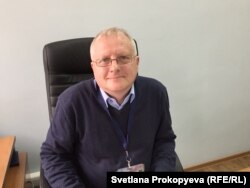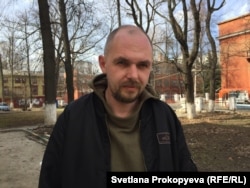NIZHNY NOVGOROD, Russia -- In less than a month, the world will come to Russia for the 2018 World Cup soccer championship. And one of the 11 cities throwing open its gates is the Volga River metropolis of Nizhny Novgorod.
Local officials insist that everything is ready for the big event, although an alarming number of blue construction fences remain throughout the city. The Nizhne-Volzhskaya Embankment lies behind such a fence, as it has for nearly a decade. But that fence, too, officials say, will come down this month.
"Virtually all the main tasks have been completed," says regional Deputy Sports Minister Aleksei Moskvin. "All we need to do now is clean up a little bit, finish here and there, and conduct operational exercises."
The academic year was cut short for local university students, as the dormitories were cleared out to house security personnel and National Guard troops.
"They chopped two months off the academic year, which for me was crazy," a student at the local branch of the Higher School of Economics, who asked not to be identified for fear of reprisals, told RFE/RL. "Of course, this affected the progress of many students. The last month was completely packed with one test after another. The quality of the material submitted left a lot to be desired."
The center of attention is the new world-class Nizhny Novgorod stadium at the confluence of the Oka and Volga rivers, with a capacity of nearly 45,000 fans. The glass-fronted venue has already hosted three home matches of the local Olimpiyets soccer team, the city's beleaguered Division 2 squad.
In all, Russia spent 70 billion rubles ($1.1 billion) getting Nizhny Novgorod into shape for the World Cup. In addition to the stadium and some three dozen other athletic facilities, the city got a new airport terminal, a new subway station, and a completely renovated railway station.
According to the original World Cup plan, some 270 historical and cultural objects were to undergo restoration to spruce them up for the throngs of fans. The local administration, however, quickly fell behind on the targets, and now it appears the actual number of restored buildings will be no more than a few dozen, says local preservation activist Anna Davydova.
"They are only painting the facades, and even that is being done badly," she tells RFE/RL. "The money allocated has been minimal; the workers are unqualified; and there are no restoration plans. We are now tracking them just to keep the harm to a minimum -- so that no details are lost and nothing superfluous is slapped on. Or, God forbid, so that nothing is torn down."
Davydova expressed gratitude for current Nizhny Novgorod Governor Gleb Nikitin, who replaced Valery Shantsev in 2017, for imposing a moratorium on the demolition of historic buildings.
"Under Shantsev, whole blocks of old structures were leveled under the pretext of preparing Nizhny Novgorod for the World Cup," Davydova says.
"We have known the World Cup was coming to Nizhny Novgorod since 2012," she adds. "We understood that this represented a huge undertaking for the city, so activists began thinking about how to prepare quite early."
But, she says, the previous administration "refused to discuss the topic with activists or local residents."
"They took all responsibility for coordinating with [world soccer governing body] FIFA and handled everything with strict administrative methods."
Activists, for example, expressed concern that the city had designated Minin and Pozharsky Square, which abuts the city's kremlin, as a so-called fan zone.
"Soccer fans aren't going to be particularly careful about the architectural monuments there, and the narrow medieval streets [surrounding the square] are not exactly designed for public transport," Davydova says.
One question on many people's minds is what will become of the massive Nizhny Novgorod stadium after the World Cup winds down. Local officials hope ownership of the facility will be handed over to the regional government.
"If the stadium is transferred to us, of course, the local soccer team and other sports organization will be able to use it for free," regional Deputy Sports Minister Moskvin told RFE/RL. "If it will be federal property, they will have to rent it."
Currently, the second-division Olimpiyets team plays at the Lokomotiv stadium, which was built in 1932 and holds about 18,000 spectators.
"If we get the new stadium, the team will win and everyone will feel better -- not like now," Olimpiyets spokesman Sergei Kozunov says. "Then we'll be able to draw in any number of spectators."
For now, though, the relatively luckless team rarely pulls in more than 6,000 fans.
"Last year, when the team offered free admission and gave away prizes, the seats at Lokomotiv were about half full," Olimpiyets fan Roman Malchikov says.
"When the World Cup ends, the stadium will slowly be reduced to ruins that are periodically rented out for some mass events," he adds. "But over the last 40 years, Pink Floyd and Metallica haven't come here, so I don't think there will be much demand for big events."
He says that real fans come to support the team, not to "look at the stadium."
Malchikov says that what the team needs is a new generation of local players, trained at quality facilities and supported by local officials.
"But I don't think these new soccer players will grow up before the stadium falls apart," he says.
The Olimpiyets players have already tasted the glory of playing in a world-class stadium during the three test matches they played there.
"Our players haven't played much in big stadiums," spokesman Kozunov says. "When they came out into Nizhny Novgorod, which we have been testing, many of them had their mouths gaping. When you come out onto the pitch, you just want to say, 'Ahhh.'"
The other World Cup host cities are: Kaliningrad, Kazan, Moscow, Rostov-on-Don, St. Petersburg, Samara, Saransk, Sochi, Volgograd, and Yekaterinburg. Nine of the 12 venues have been built from scratch for the event, while three have undergone total renovation.
The official budget for the World Cup is $11 billion. Russian government officials said in January that Moscow expects between 3 million and 5 million foreign guests to come for the tournament.













